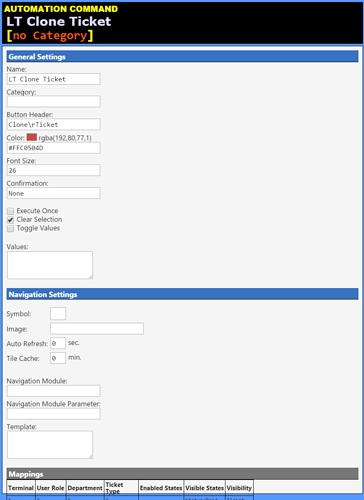Automation Commands
LT Clone Ticket [no Category] (Automation Command)
| Name: | LT Clone Ticket |
| Category: | |
| Button Header: | Clone\rTicket |
| Color: | #FFC0504D |
| Font Size: | 26 |
| Confirmation: | None |
Values (0): (none)
Navigation Settings
| Symbol: | |
| Image: | |
| Auto Refresh: | 0 |
| Tile Cache: | 0 |
| Navigation Module: | |
| Nav Module Parameter: | |
Template:
```
</details>
<details>
<summary><b><u>Mappings</u></b></summary><table><tr><td><b>Terminal</b> </td><td><b>User Role</b> </td><td><b>Department</b> </td><td><b>Ticket Type</b> </td><td><b>Enabled States</b> </td><td><b>Visible States</b> </td><td><b>Visibility</b> </td></tr><tr><td><code>*</code></td><td><code>*</code></td><td><code>*</code></td><td><code>*</code></td><td><code></code></td><td><code>Status=Paid</code></td><td><code>Ticket</code></td></tr></table></details>
----------
<img src="/uploads/default/original/3X/9/0/90b0dbc368cbdecdeafdef9a408045c85a423e8f.png" width="364" height="500">
>## LT Display Last Ticket `[no Category]` (Automation Command) ##
<table><tr><td><b>Name:</b> </td><td><code>LT Display Last Ticket</code></td></tr><tr><td><b>Category:</b> </td><td><code></code></td></tr><tr><td><b>Button Header:</b> </td><td><code>Display Last\rSettled Ticket</code></td></tr><tr><td><b>Color:</b> </td><td><code>#FFC0504D</code></td></tr><tr><td><b>Font Size:</b> </td><td><code>26</code></td></tr><tr><td><b>Confirmation:</b> </td><td><code>None</code></td></tr></table>
<b>Values (0):</b> <i>(none)</i>
<details>
<summary><b><u>Navigation Settings</u></b></summary><table><tr><td><b>Symbol:</b> </td><td><code> </code></td></tr><tr><td><b>Image:</b> </td><td><code> </code></td></tr><tr><td><b>Auto Refresh:</b> </td><td><code>0</code></td></tr><tr><td><b>Tile Cache:</b> </td><td><code>0</code></td></tr><tr><td><b>Navigation Module:</b> </td><td><code> </code></td></tr><tr><td><b>Nav Module Parameter:</b> </td><td><code> </code></td></tr></table>
<b>Template:</b>
</details>
<details>
<summary><b><u>Mappings</u></b></summary><table><tr><td><b>Terminal</b> </td><td><b>User Role</b> </td><td><b>Department</b> </td><td><b>Ticket Type</b> </td><td><b>Enabled States</b> </td><td><b>Visible States</b> </td><td><b>Visibility</b> </td></tr><tr><td><code>*</code></td><td><code>*</code></td><td><code>*</code></td><td><code>*</code></td><td><code></code></td><td><code>Status=New</code></td><td><code>Ticket</code></td></tr></table></details>
